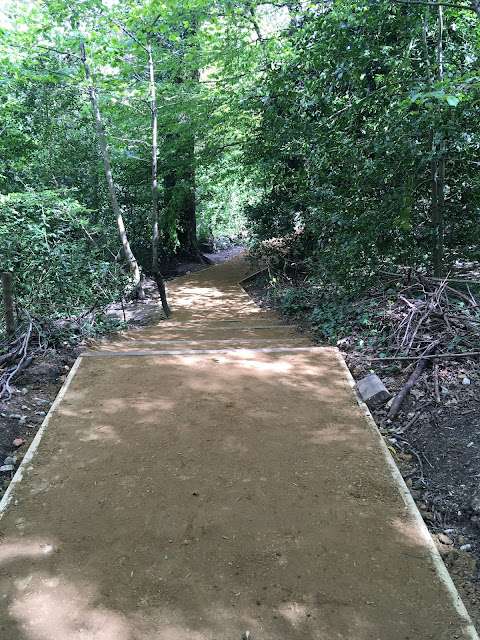Improving the Paths.
The clay soils of the Wood create problems for walking in the wetter winter months. The clay becomes saturates quickly and excess water lies on the surface. This make paths very slippery and in places, waterlogged.
 |
The problem of waterlogging is seen clearly in the winter view of the path leading down from the folly to the old railway alignment.
|
Where this happens, people will attempt to avoid the worst sections by leaving the path and walking alongside on vegetation which gives a more secure foothold. Of course, this results in a wider path and damage to the plants which is often irreparable. The threefold increase in visitors during lock-downs and the need to observe social distancing has made matters worse, This can be seen in the tennis court glade where the path in now at least twice as wide as it used to be and alongside the path leading down from the Cedar of Lebanon, where a new path has been cut through a patch of wild garlic.
 |
The extent to which the path through the tennis court glade has been widened can be seen. The original width would have been between the red lines drawn on the photo.
|
Therefore, approximately 180 metres of the busiest paths have been improved to provide a more secure surface for walkers and encourage them to keep to the designated paths rather than straying off them and causing damage. This has been carried out as a result of funding from the Great North Wood Project. Those sections which have seen work are:
1. The main path up from the containers to the top of the tunnel mouth;
2. The path from the cedar of Lebanon to the tennis court glade;
3. The path from the old railway line to the folly;
4. A section of the upper path behind the main glade which was particularly prone to waterlogging.
The work has been carried out by contractors and not volunteers, as the scale and complexity required professional skills. A mechanised digger prepared the path, including drainage pipes where necessary. Next, wooden edging was installed and the space in between filled with hard core, and finally, this was topped with a self binding sand known as hoggin. This is the most common way to improve paths in setting such as the Wood as it provides a permeable but robust surface which weathers to a natural appearance. As it prevents waterlogging, these sections of path will provide a more attractive route for walkers, so allowing the areas on each side of the path to recover from trampling.
 |
The path between the tennis court glade and the Cedar of Lebanon in the process of improvement. The path has been levelled, drainage installed and a layer of hard core tamped in between the wooden edging.
|
|
 |
The path is completed with a compacted layer of hoggin.
|
 |
| This section of the upper path was notorious for turning into a swamp in wet weather. The new drainage and path will solve this problem and new steps have been installed as part of this section of improvement. |
|
 |
The finished section .
|
The path down from the main Crescent Wood Road entrance had suffered extensive erosion and damage during the successive lock-downs, especially the section from above the tunnel down to the old railway alignment. This section has been repaired and upgraded and new drainage installed which will prevent the flooding which took place by the containers.
 |
A new even path leading up to Crescent Wood Road. This has now been completed with a surface layer of hoggin.
|
This programme of path improvements illustrates the balance needed between conserving the woodland and minimising the impact of humans. Although some people might find the new paths artificial looking, they will weather and blend into the landscape but equally important, is their role in helping to prevent damage to the woodland flora as a result of trampling. Most people will appreciate the the repairs to the most degraded sections of path.











Comments
Post a Comment